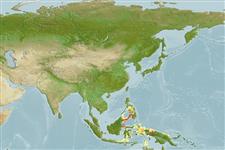Actinoptérygiens (poissons à nageoires rayonnées) >
Perciformes (Perch-likes) >
Labridae (Wrasses) > Cheilininae
Etymology: Cirrhilabrus: Latin, cirrus = curl fringe + Greek, labros = furious (Ref. 45335); cenderawasih: Named for its type locality, Cenderawasih Bay; noun in apposition.
Environnement / Climat / Gamme
Écologie
; marin récifal; profondeur 22 - 60 m (Ref. 75881). Tropical, preferred ?
Western Pacific: Indonesia.
Taille / Poids / Âge
Maturity: Lm ? range ? - ? cm
Max length : 6.5 cm SL mâle / non sexé; (Ref. 75881); 4.7 cm SL (female)
Description synthétique
Morphologie | Morphométrie
Épines dorsales (Total): 11; Rayons mous dorsaux (Total): 9; Épines anales 3; Rayons mous anaux: 9. This species is distinguished by the following characters: D XI, 9; A III, 9; pectoral rays 15; lateral-line scales 14-16 + 6-9; median predorsal scales 5; horizontal scale rows on cheek below eye 2; gill rakers 14-17; body depth 2.9-3.2 in SL; head length 2.9-3.2 in SL; snout length 3.8-4.7 in head; males' caudal fin strongly lunate with produced lobes; pelvic fins relatively short, not reaching anal fin origin when depressed; live colour pattern features of males include a pink overall coloration with broad, irregular yellow stripe or rectangular blotch on middle of side, and series of 4-5 large, irregular black blotches along back, extending on to adjacent basal portion of dorsal fin; female mainly reddish pink with pupil sized black spot on upper caudal peduncle (Ref. 75881).
This species is common on sheltered seaward reefs, primarily on the inner and eastern portions of the Cenderawasih Bay at depths between about 22 to 60 m, although it is more abundant below about 35 m. Observed to be in groups of about 10 to 20 individuals, including one to five males, and were typically encountered on rubble slopes or on rubble substrates at the base of slopes. Apparently feeds on zooplankton, which is typical for the genus, at a short distance above the bottom (Ref. 75881).
Life cycle and mating behavior
Maturité | Reproduction | Frai | Œufs | Fécondité | Larves
Distinct pairing during breeding (Ref. 205).
Allen, G.R. and M.V. Erdmann, 2006. Cirrhilabrus cenderawasih, a new wrasse (Pisces: Labridae) from Papua, Indonesia. Aqua J. Ichthyol. Aquat. Biol. 11(3):125-131. (Ref. 75881)
Statut dans la liste rouge de l'IUCN (Ref. 115185)
CITES (Ref. 94142)
Not Evaluated
Menace pour l'homme
Harmless
Utilisations par l'homme
Plus d'informations
PaysZones FAOÉcosystèmesOccurrencesIntroductionsStocksÉcologieRégime alimentaireÉléments du régime alimentaireConsommation alimentaireRation
Taille/ÂgeCroissanceLongueur-poidsLongueur-longueurFréquences de longueursMorphométrieMorphologieLarvesDynamique des populations larvairesRecrutementAbondance
RéférencesAquacultureProfil d'aquacultureSouchesGénétiqueFréquences alléliquesHéritabilitéPathologiesTraitementMass conversion
CollaborateursImagesStamps, CoinsSonsCiguateraVitesseType de nageSurface branchialeOtolithesCerveauxVision
Outils
Articles particuliers
Télécharger en XML
Sources Internet
